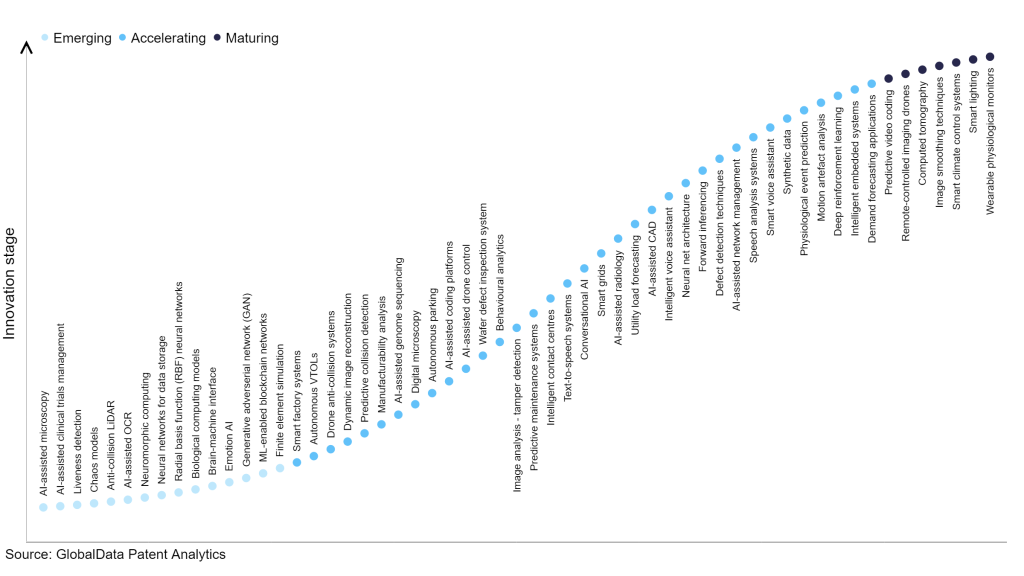The technology industry continues to be a hotbed of innovation, with activity driven by the amalgamation of technological progress, heightened connectivity, and the urgency for businesses to enhance efficiency and competitiveness in an ever-changing marketplace, as well as growing importance of technologies such as machine learning, deep learning, natural language processing, and computer vision. These technologies work together to improve the accuracy, speed, and reliability of optical character recognition (OCR) tasks, enabling efficient and effective extraction of text from images or scanned documents. In the last three years alone, there have been over 3.6 million patents filed and granted in the technology industry, according to GlobalData’s report on Innovation in Artificial Intelligence: AI-assisted OCR. Buy the report here.
However, not all innovations are equal and nor do they follow a constant upward trend. Instead, their evolution takes the form of an S-shaped curve that reflects their typical lifecycle from early emergence to accelerating adoption, before finally stabilising and reaching maturity.
Identifying where a particular innovation is on this journey, especially those that are in the emerging and accelerating stages, is essential for understanding their current level of adoption and the likely future trajectory and impact they will have.
300+ innovations will shape the technology industry
According to GlobalData’s Technology Foresights, which plots the S-curve for the technology industry using innovation intensity models built on over 2.5 million patents, there are 300+ innovation areas that will shape the future of the industry.
Within the emerging innovation stage, finite element simulation, ML-enabled blockchain networks, and generative adversarial network (GAN) are disruptive technologies that are in the early stages of application and should be tracked closely. Demand forecasting applications, intelligent embedded systems, and deep reinforcement learning are some of the accelerating innovation areas, where adoption has been steadily increasing. Among maturing innovation areas are, wearable physiological monitors, smart lighting, and smart climate control systems, which are now well established in the industry.
Innovation S-curve for artificial intelligence in the technology industry

AI-assisted OCR is a key innovation area in artificial intelligence
AI-assisted optical character recognition (OCR) is an advanced technology that harnesses the power of artificial intelligence (AI) and machine learning algorithms to identify and extract text from digital images and scanned documents. This innovative technology enables the swift conversion of printed or handwritten documents into machine-readable text, eliminating the need for time-consuming manual data entry. By automating the process, AI-assisted OCR significantly streamlines workflows and enhances productivity.
GlobalData’s analysis also uncovers the companies at the forefront of each innovation area and assesses the potential reach and impact of their patenting activity across different applications and geographies. According to GlobalData, there are 110+ companies, spanning technology vendors, established technology companies, and up-and-coming start-ups engaged in the development and application of AI-assisted OCR.
Key players in AI-assisted OCR – a disruptive innovation in the technology industry
‘Application diversity’ measures the number of different applications identified for each relevant patent and broadly splits companies into either ‘niche’ or ‘diversified’ innovators.
‘Geographic reach’ refers to the number of different countries each relevant patent is registered in and reflects the breadth of geographic application intended, ranging from ‘global’ to ‘local’.
Patent volumes related to AI-assisted OCR
Source: GlobalData Patent Analytics
Samsung is one of the leading patent filers in AI-assisted OCR. The company’s patents are aimed at a client device configured with a neural network including a processor, a memory, a user interface, a communications interface, a power supply, and an input device, wherein the memory includes a trained neural network received from a server system that has trained and configured the neural network for the client device. It also filed patents related to server systems and methods of training neural networks.
Other prominent patent filers in the space include ADOBE and Alphabet.
In terms of geographical reach, PlusAI leads the pack, followed by KDDI and Magic Leap. In terms of application diversity, Enlitic holds the top position, followed by Memjet Technology and Butterfly Network.
The significance of AI-assisted OCR lies in its ability to streamline operations, improve data accuracy, reduce costs, enhance searchability, ensure compliance, enable data analysis, and support multilingual recognition.
To further understand how artificial intelligence is disrupting the technology industry, access GlobalData’s latest thematic research report on Artificial Intelligence (AI) – Thematic Intelligence.
Data Insights
From

The gold standard of business intelligence.
Blending expert knowledge with cutting-edge technology, GlobalData’s unrivalled proprietary data will enable you to decode what’s happening in your market. You can make better informed decisions and gain a future-proof advantage over your competitors.







